We have some new major new acquisitions which relate to the Type C-1 AFCE or “autopilot.” So, let’s get into detail…
The Automatic Flight Control Equipment was critical to the success of the Norden bombsight. Developed by Minneapolis Honeywell, the C-1 autopilot was an electric system of gyros which allowed the bombardier to pilot the aircraft via the bombsight. The aircraft’s control cables were run through a series of servos (pitch, roll, and yaw), all connected to a gyro which held the aircraft level. The bombsight sat on a stabilizer, itself containing a gyro, designed to hold the aircraft on course toward the target highlighted by the bombsight. This system was activated (and fine-tuned) by a control panel in the cockpit, with the system’s amplifier, inverter, and fuse box all located under the cockpit floor.
As far as I am aware, there are only two complete, working examples of C-1 autopilots in the world today, neither of which are in the US. It is our sincere hope that we can put together a complete, working C-1 autopilot system for Lucky Thirteen.
In actuality, this is a bit of an unexpected, early start. But when opportunity comes, you must be ready! It left us a little short on funds so we’ll have to build them back up – but it was totally worth it.
Our dear friend Andy Rivera has long offered us a NOS Type M-9 Norden Bombsight, but we lacked a stabilizer to mount it to. (So he’s been patiently waiting.) However, by chance we were recently able to acquire a stabilizer from J. Richard de Boer of the Calgary Mosquito Society. De Boer is a great guy and the work they’re doing up there is phenomenal. Through him, we were also given the opportunity to acquire the system’s amplifier and second servo.
We already had one servo, which we was donated by Joe McKowen, as well as three examples of the system’s inverter. Longtime followers might also recall that the recent crate from Belgium contained an autopilot gyroscope. This gyroscope was taken from “K-King” (44-6139, 351BG), a B-17G which crash-landed near Villers-lez-Heest on 12 September 1944. Cared for by the Bodart family, this gyroscope is still in pristine condition.
As such, the only components left for us to locate are the Type A-6A autopilot control panel, the G1028A6CA1 fuse box, and a third servo unit. More importantly, our stabilizer unit is missing several pieces, which we will have to replace before we can attach Andy’s bombsight. These include the torque motor, the bombsight clutch assembly, and the PDI pot and drift gear assembly. The directional arm lock is also a late-war type, which we will need to exchange for the older variant. Likewise, we have been offered a Type A-6A control panel if we can locate a switch box used to tie the system to joystick control (a late-war addition).
If you can help us complete the Type C-1 Autopilot for Lucky Thirteen – either by locating components or missing pieces – please do let us know!
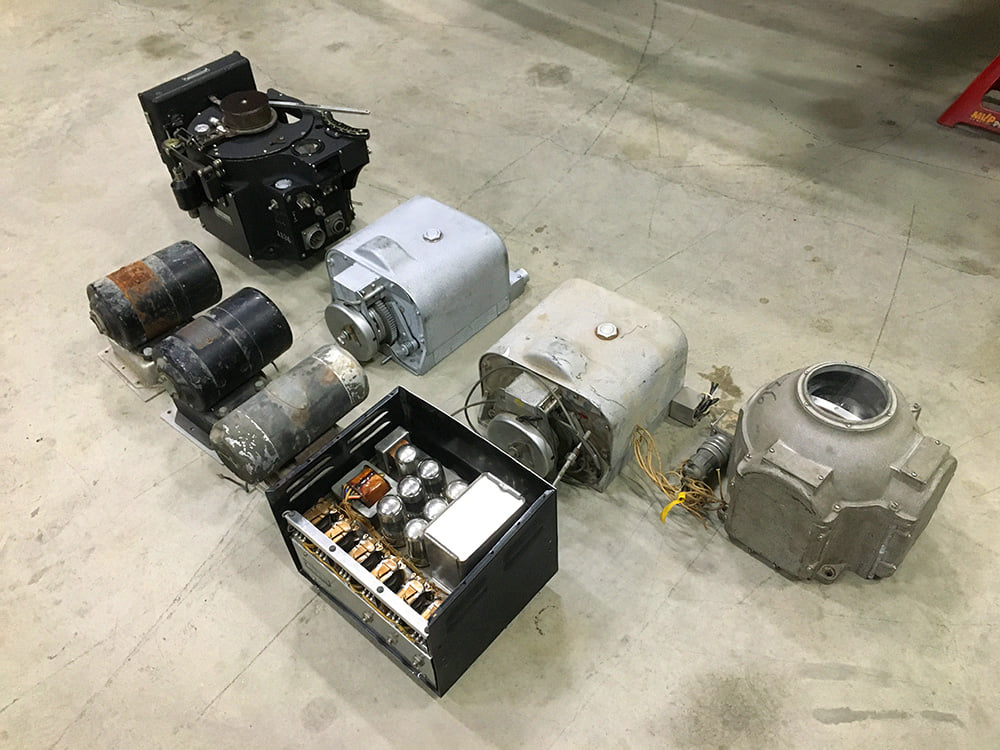
All of autopilot components that Hangar Thirteen has been able to gather thus far.
Photo taken 2 November 2021.
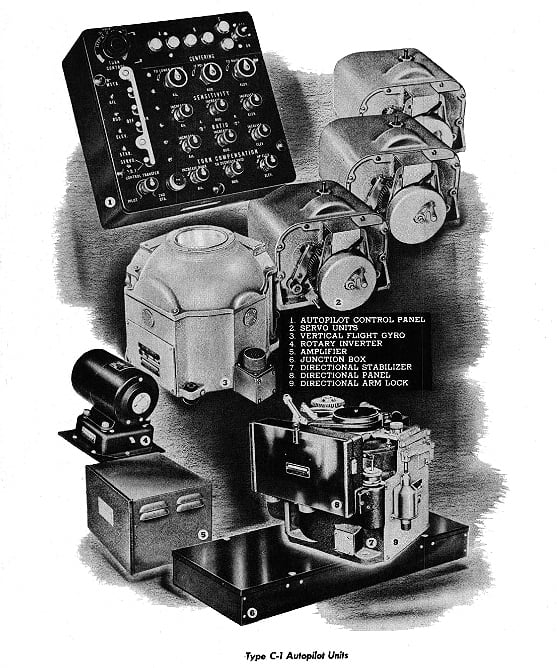
A manual illustration showing all the components to the Type C-1 autopilot system.
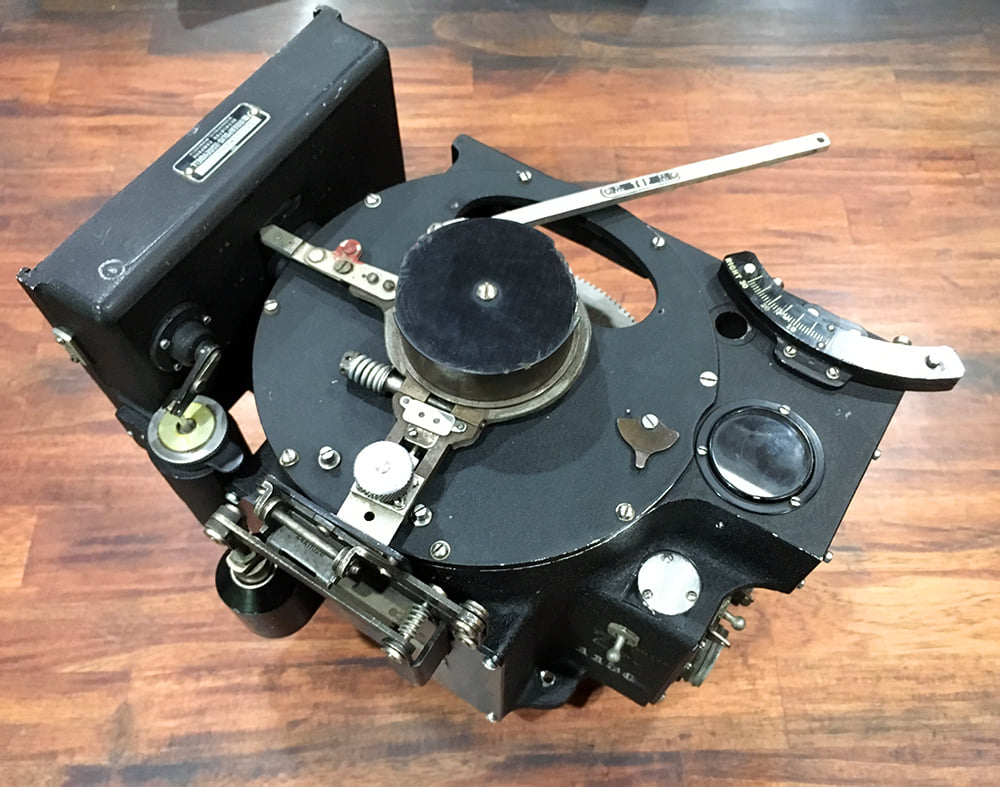
The newly-arrived bombsight stabilizer is cleaned.
Photo taken 11 October 2021.
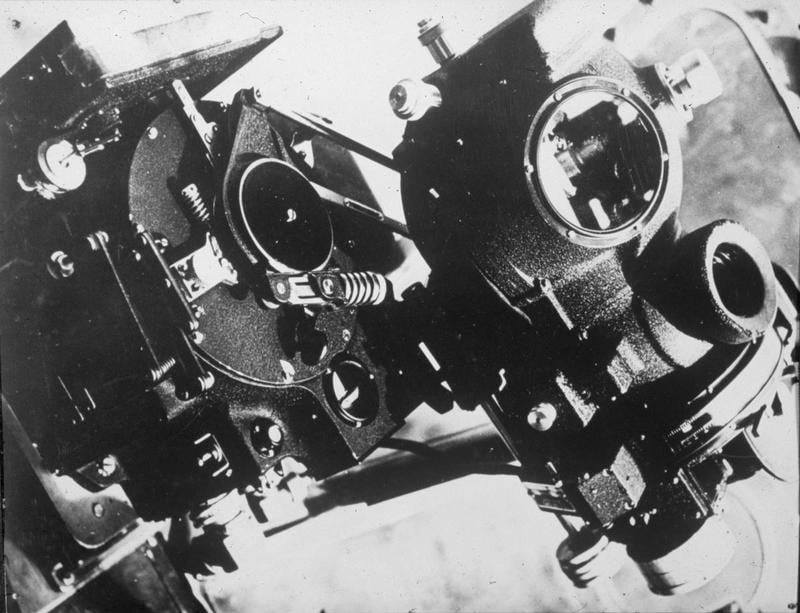
One of the first photographs of the Norden bombsight shown to the public, released on 17 November 1944.
Note how the bombsight mounts to the stabilizer below.
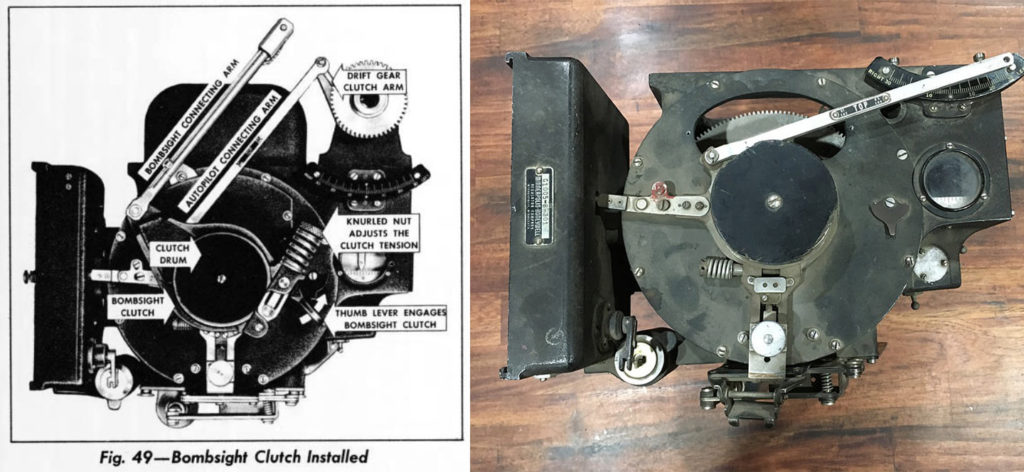
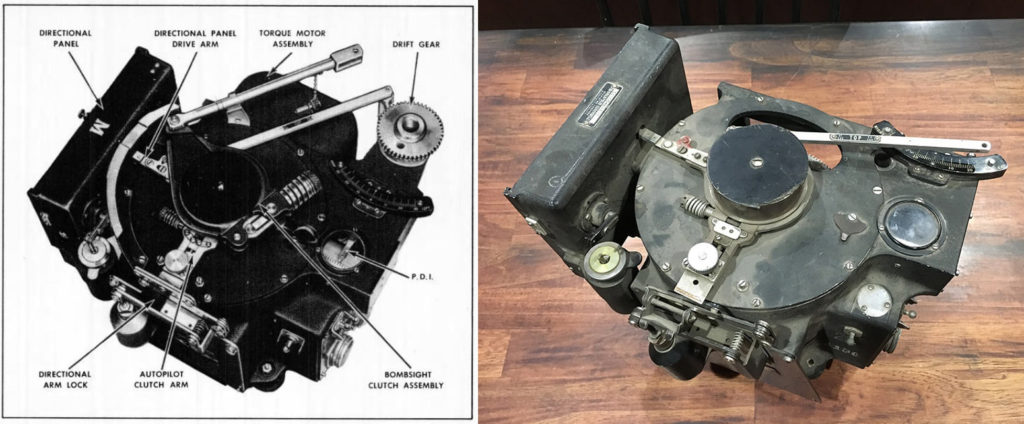

A comparison between the stabilizer (prior to cleaning) and the manual illustration highlights the missing components.
If you can help us replace the missing components, PLEASE let us know!
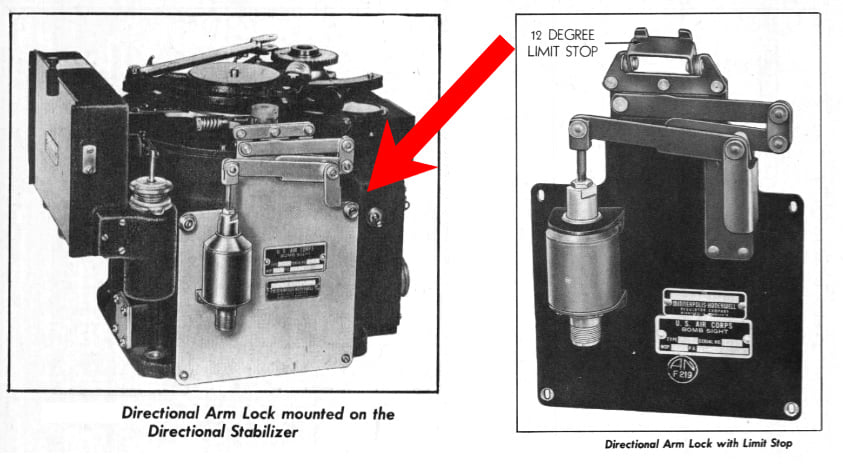
A comparison between the early and late versions of the directional arm lock. We need the type highlighted by the arrow.
If you can help us switch out our late arm lock with an early variant, PLEASE let us know!

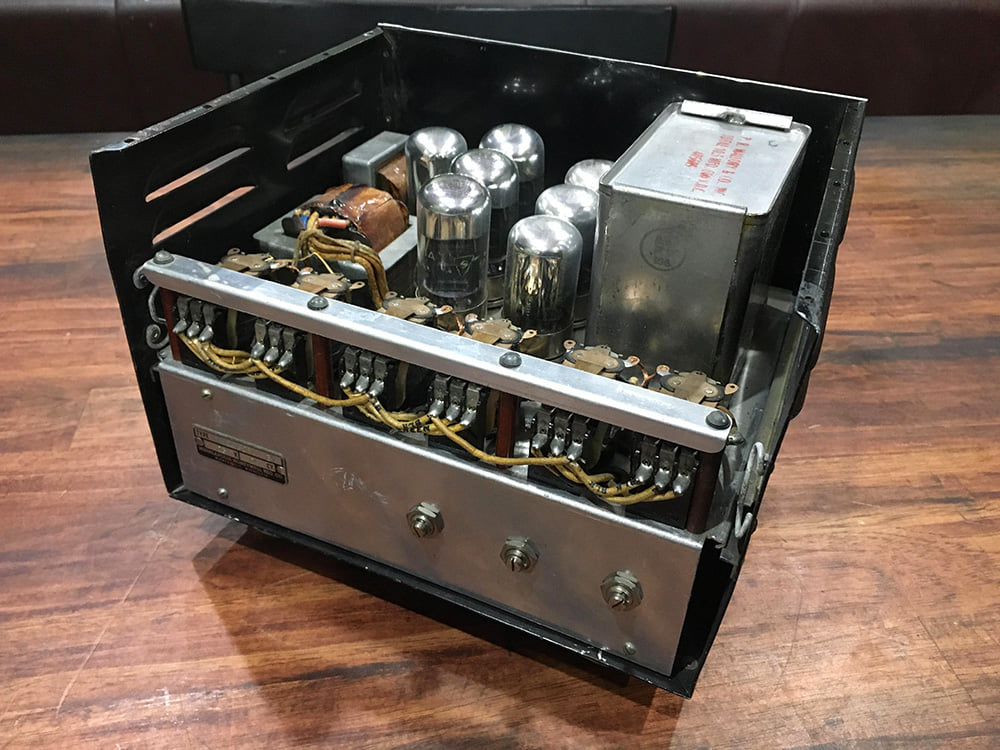
The newly-arrived autopilot amplifier unit.
Our friend Dom Serong has offered to provide the measurements necessary to recreate the missing cover piece.
Photo taken 24 October 2021.
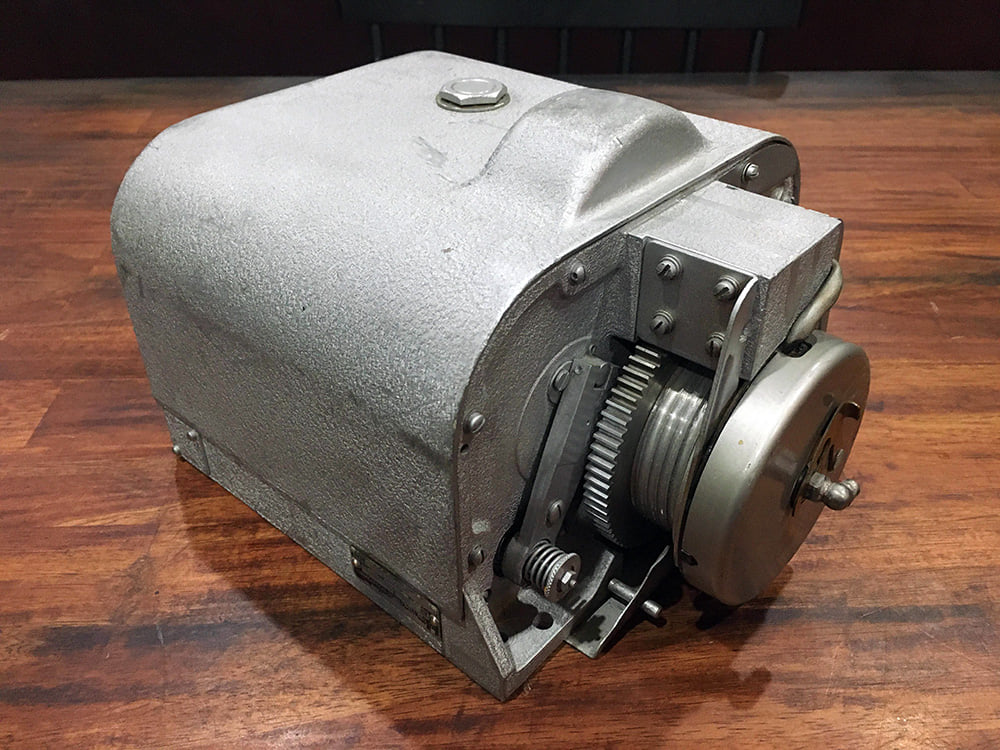
The newly-arrived autopilot servo.
Photo taken 24 October 2021.
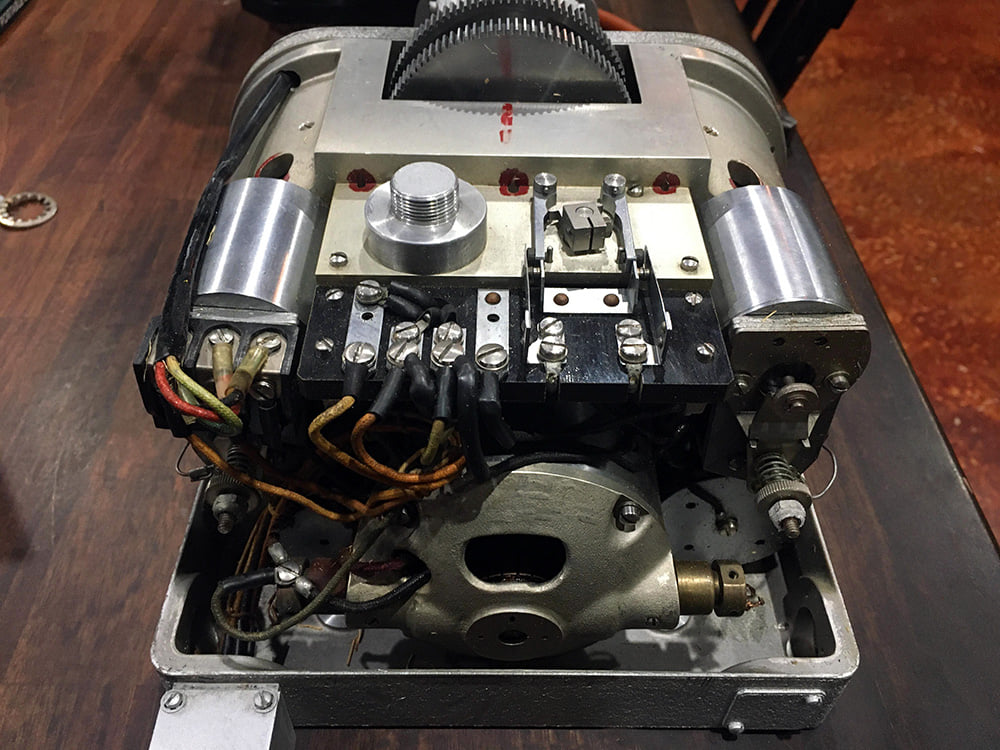
The cover is removed from the newly-arrived autopilot servo.
There is a piece here that serves as a limit switch, and was supposed to be filed according to whatever aircraft it was installed aboard. Because this piece appears unaltered, we believe this servo may have never been installed aboard an aircraft before.
Photo taken 24 October 2021.
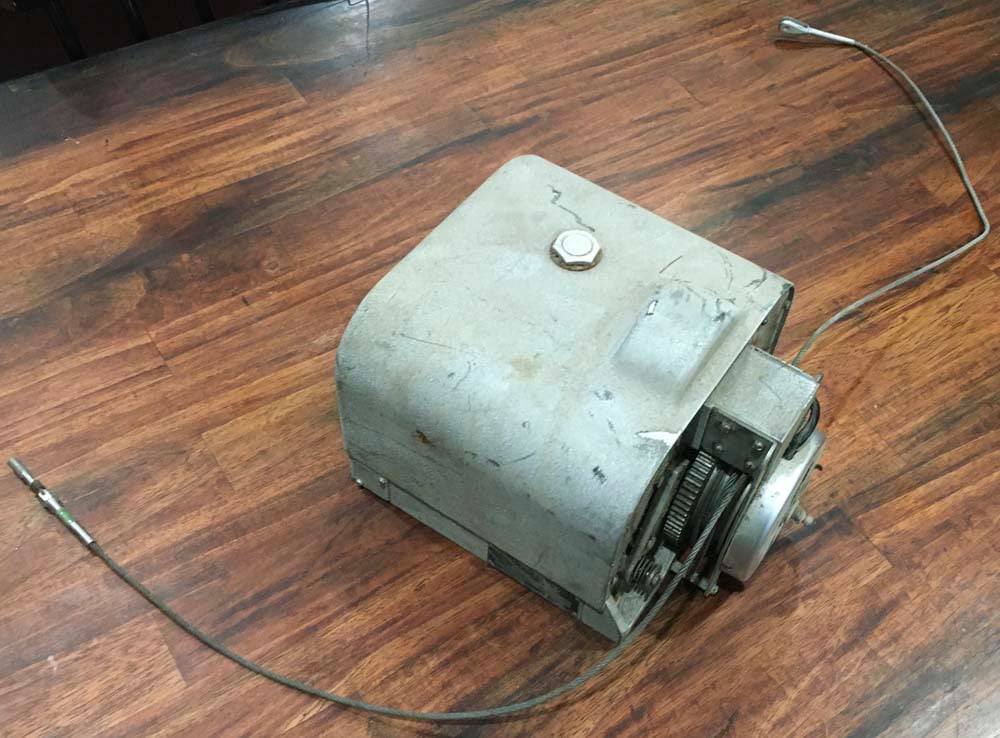
The autopilot servo donated to us by Joe McKowen.
Note the control cables from whatever aircraft it was originally installed are still wrapped around the drum assembly.
Photo taken 18 September 2020.
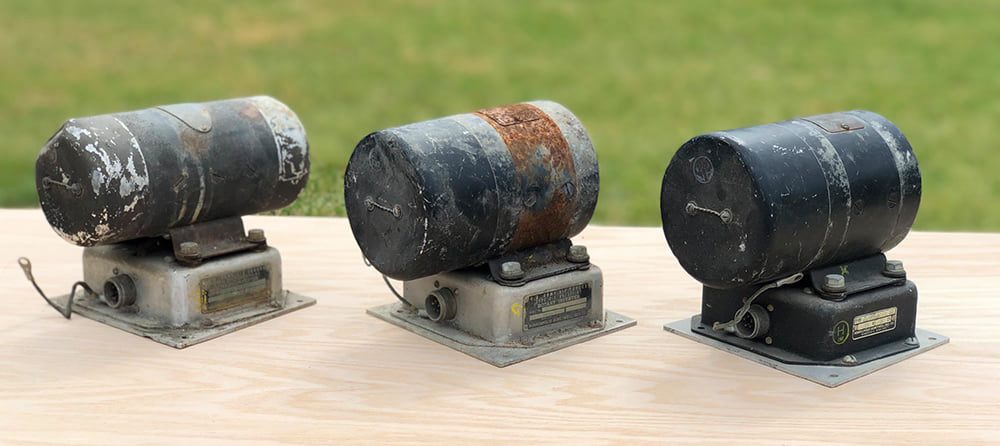
The autopilot inverters donated by Joe McKowen.
Two companies made inverters for Minneapolis Honeywell – Westinghouse Electric of Pittsburgh (who made the left-most unit) and Eicor Inc. of Chicago (who made the two right-hand units). Eicor was purchased by Indiana General Corp. in 1962 and dissolved shortly thereafter.
Photo taken 17 April 2021.
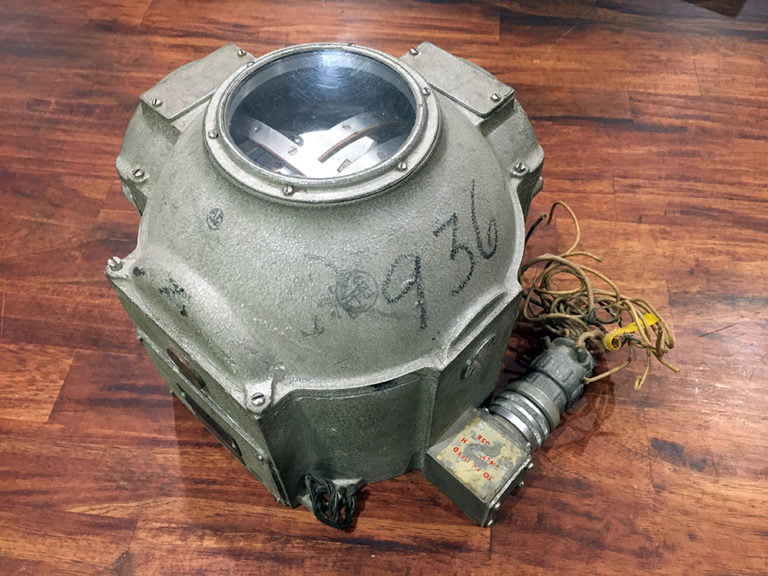
The autopilot gyro from “K-King” (44-6139, 351BG). One can hardly describe how pristine this piece is. All it needs is to be plugged in!
Photo taken 29 June 2021.
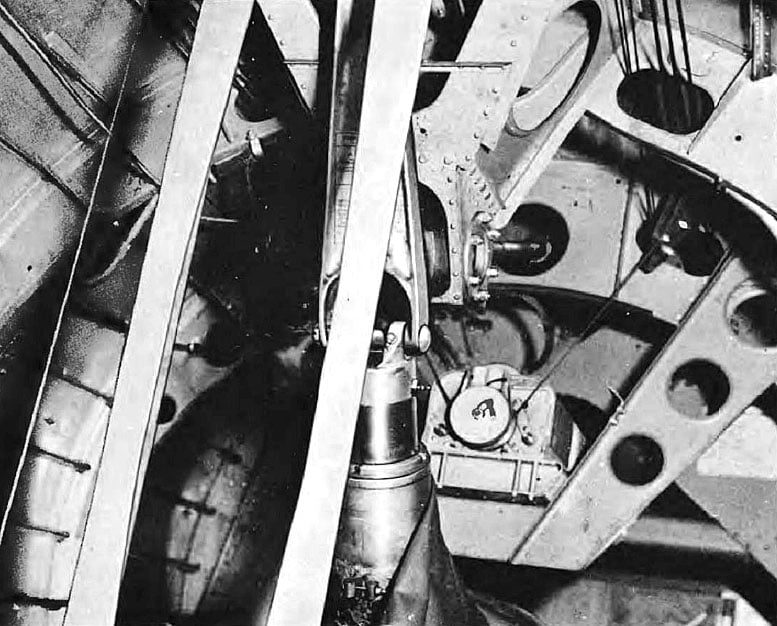
On a shelf hanging over the tailwheel sits two of the autopilot servos, pulling the cables to the elevator and rudder.
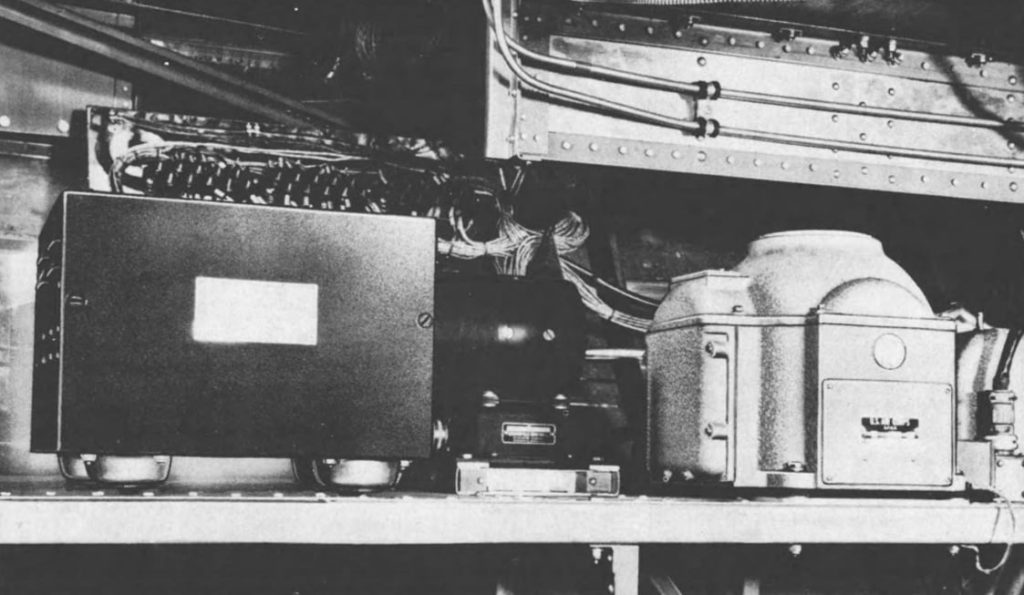
Under the cockpit floor sits (from left to right) the autopilot amplifier, inverter, and gyroscope.
The inverter in this illustration is an Eicor type.

Another view of the autopilot equipment under the cockpit floor.
Here you can see the aileron servo (bottom left) and the G1028A6CA1 fuse box, which is mounted to the wall behind the amplifier.
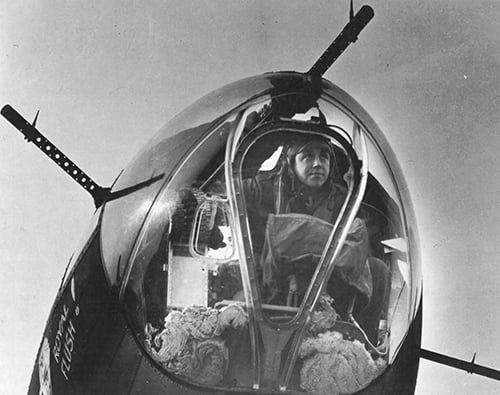
CPT Edwin R. Bush pears out the nose of Royal Flush (42-5132, 91BG).
The bombsight was removed between missions and kept in a vault at the airfield. Here the sight has not been installed, leaving just the stabilizer (which has been covered).
This was not unusual. Starting 3 January 1943, only a few bombers in each formation actually carried bombsights, as the rest of the aircraft simply dropped when the lead bomber did. This tactic eventually became common throughout multiple US air forces.
Royal Flush was lost on 22 June 1943. Bush was lost earlier aboard Invasion II (42-5070, 91BG), the bomber originally chosen by William Wyler as the subject of a documentary film. When Invasion II was shot down on 17 April 1943, Wyler opted to focus on another bomber: Memphis Belle (41-24485, 91BG). Bush survived the war but was killed in an training accident in 1952.
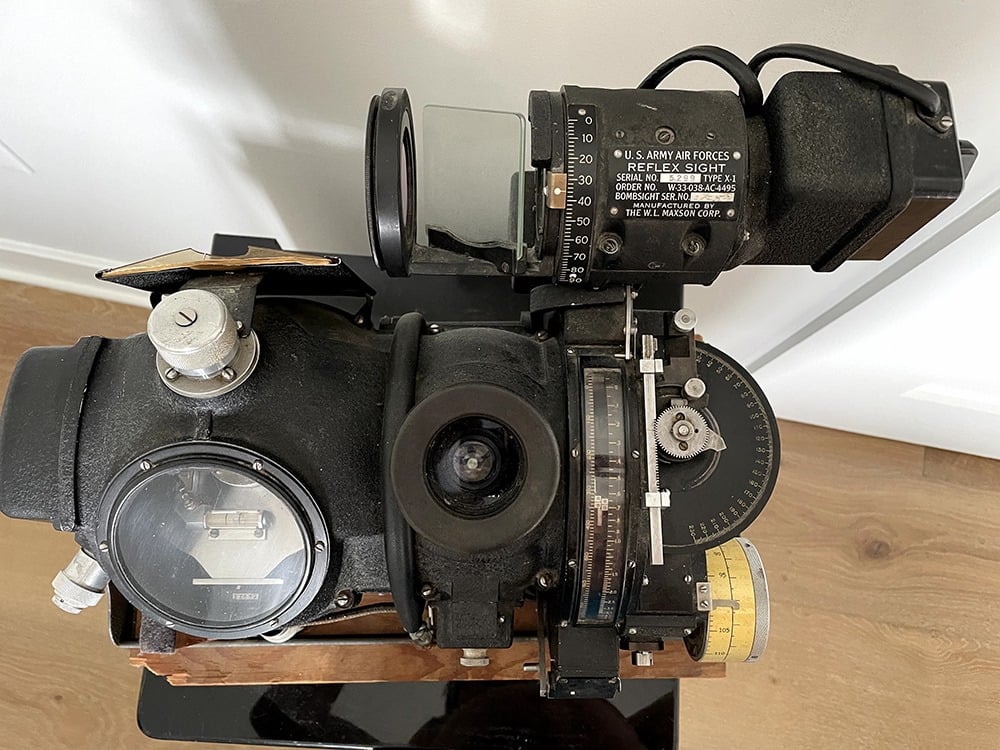

The Norden bombsight Andy has promised to Lucky Thirteen.
Photo taken 10 October 2021.
Got an INCREDIBLE array of donations to share with everyone. These donations come from SSgt Max Pearsall, currently stationed at Joint Base Elmendorf-Richardson in Alaska, and Edward Reed of Charleston, South Carolina.
Edward has been following us a long time and recently offered his NOS Type B-11 Ring sight to the project. This amazing piece was made by International Register of Chicago, Illinois and was used on Type E-8 and E-12 gun cradles, such as those used in the B-17F’s waist positions. Edward was awesome enough to package the sight in period-correct dressing, complete with twine wrapping and an array of Army Air Forces decals. Thank you SO much!
Max contacted us some weeks back, asking if he could volunteer to help track down rare pieces. Truthfully, he did not have to ask – we hope all of our followers look out for parts! Still, I rattled off to Max a list of components that we considered a bit rarer than others. Boy did he surprise!
Arriving in the mail today was a Fairchild Type K-17 Strike Camera, a Type B-14 seatbelt, a Hughes ammunition chute (right-hand feed), and a pair of patches commemorating his grandad’s aircraft. Max’s grandad was a bombardier with the 2BG (15AF), flying out of occupied North Africa and Italy. This contribution is nothing short of staggering – thank you Max!
In recognition of Max’s donation, our website now has a dedicated page for the camera equipment carried by Lucky Thirteen. It is our hope that we can restore the bomber’s strike camera system to full operation for future generations!
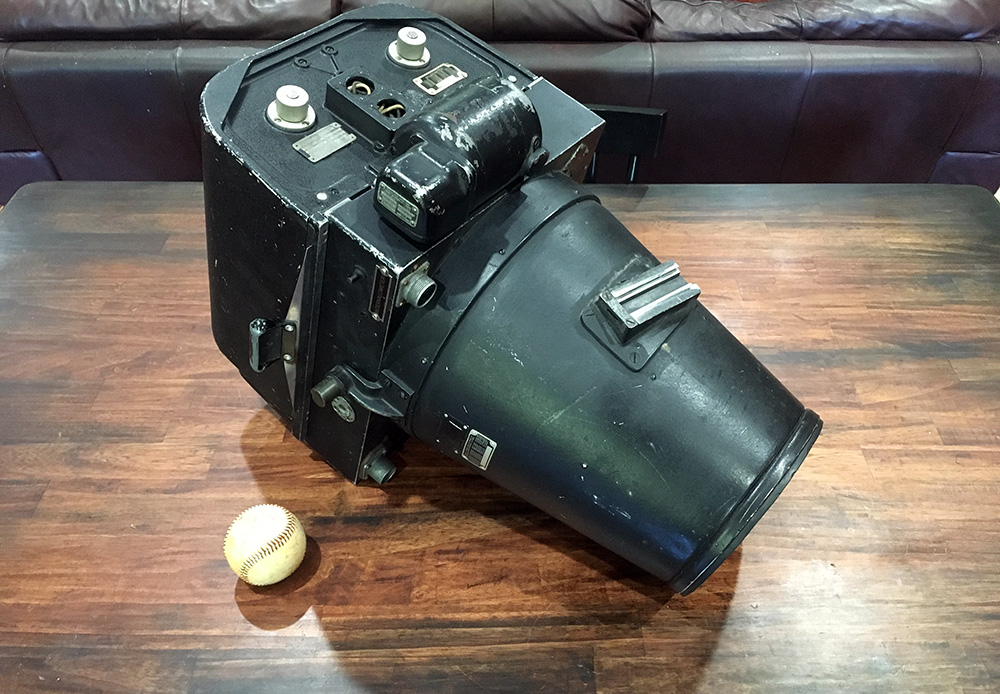
Max’s newly donated Type K-17 strike camera sitting on my dining table.
The baseball is for size comparison.
Photo taken 18 October 2021.
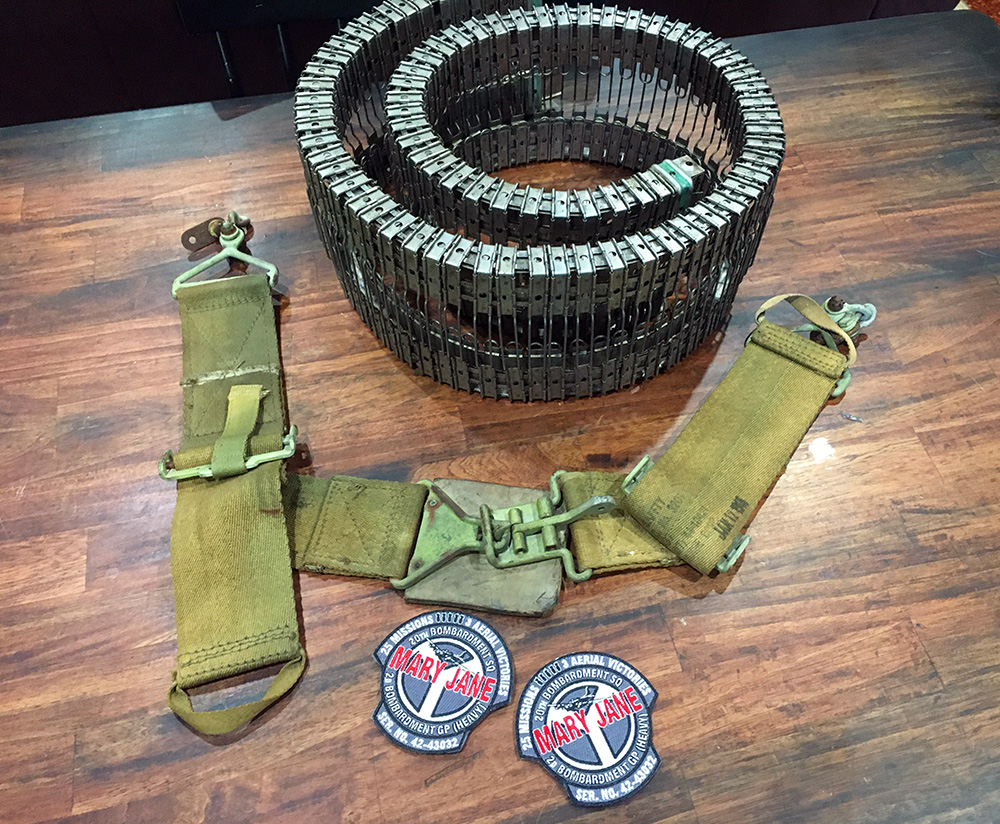
Max’s newly donated Hughes ammunition chute and Type B-14 seatbelt. These are both items of which we need plenty of examples.
The patches are custom made, commemorating his grandad’s service.
Photo taken 18 October 2021.
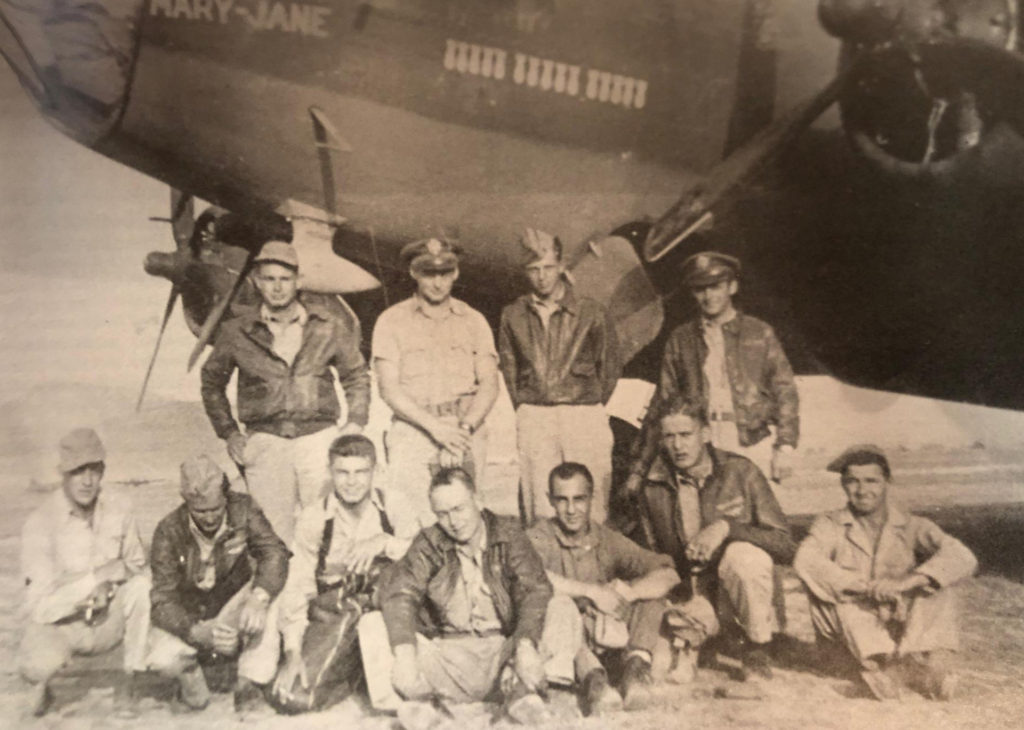
Max’s grandad, 1LT Thomas F. Morris (far right, back row), with the crew of Mary Jane (42-3032, 2BG).
Max’s grandad completed his combat tour and returned home as a bombardment instructor. He stayed in the service and also saw action as a forward observer in the Korean War.
Mary Jane – a late Douglas-F like Lucky Thirteen – also survived the war. She was transferred to the 483BG in March 1944 and ultimately scrapped at Walnut Ridge, Arkansas in December 1945.

Edward’s newly donated NOS Type B-11 ring sight.
Photo taken 16 October 2021.

The contents of Edward’s package. The ring sight is in the red wrapping.
Thank you so much, Edward. The honor is ours!
Photo taken 16 October 2021.
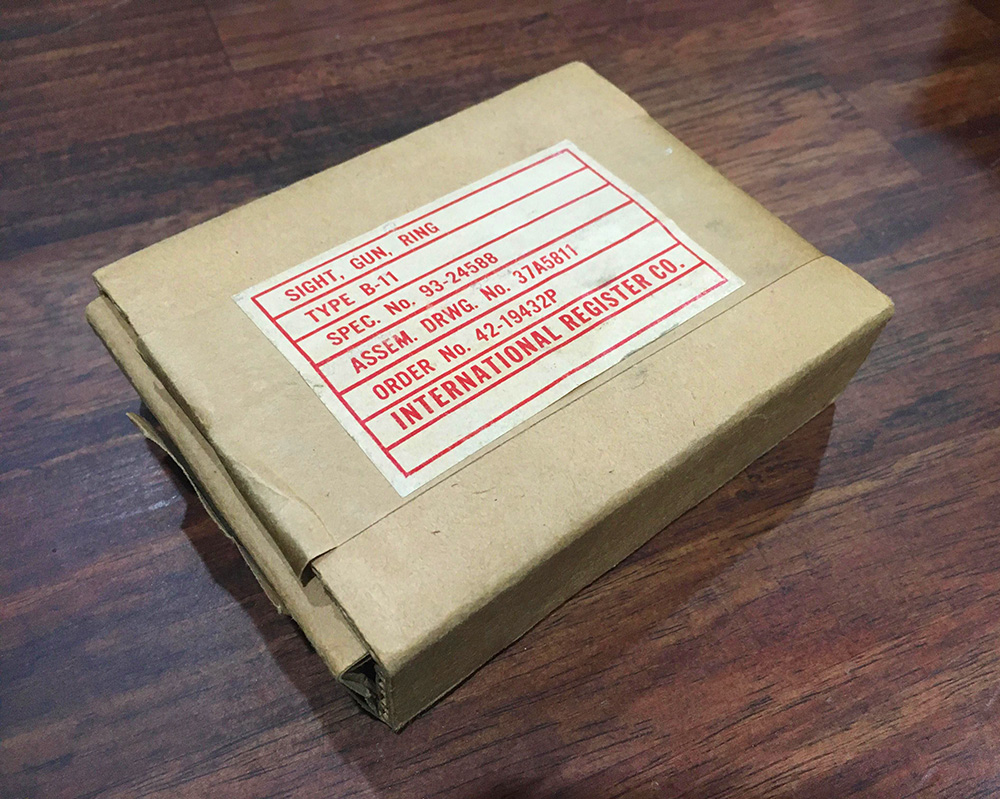
The box containing the Type B-11 ring sight.
Photo taken 16 October 2021.

SSGT Charles D. Hill poses at the right waist position aboard Meadowlark (42-5378, 306BG). The Type B-11 Ring Sight and Hughes Ammunition Chute are visible here.
Meadowlark holds the distinction of being the first US bomber over Germany. With COL Frank A. Armstrong aboard as mission leader, Meadowlark led a strike of 91 aircraft against the sub pens of Wilhelmshaven on 27 January 1943. While aerial gunners claimed 22, the actual figures were 3 US bombers lost and 7 interceptors shot down.
Meadowlark was lost on 6 March 1943 over Lorient, France.

MSGT Clarence Boyles of the 92BG. Note the Type B-11 Ring Sight and Hughes Ammunition Chute.
This is an older F-model B-17, as evidenced by the interchangeable ammo cans left of Boyles’s position. As was typical, the waist guns on this aircraft have been altered to use a belt feed system.
Note the Type A-2 ball turret in the background. A hanger and trunnion assembly, like the one you see here, has been offered to Hangar Thirteen for $24,000. So, if you’d like to see us rebuild an F-model ball turret back to operating condition, please help us raise the necessary funds!
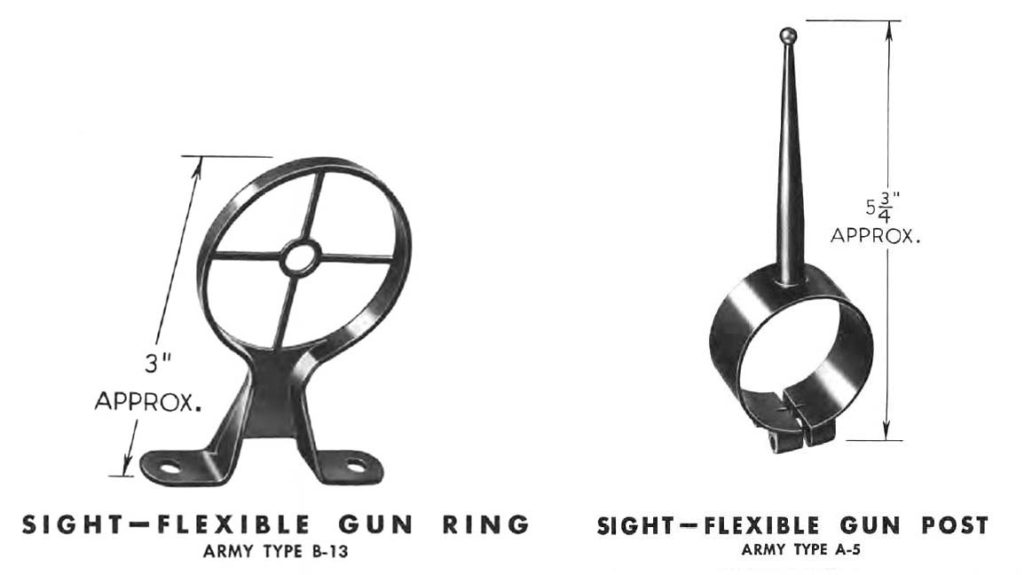
Edward’s donation completes one of the two B-11 ring sights needed for Lucky Thirteen’s waist guns.
The three guns in the nose compartment used Type B-13s (shown here). All five of the flexible guns positions used Type A-5 post sights.
The radio room gun used a ring and bead system similar to the waist gunners, but was uniquely designed so the sights could fold down. As such, the radio gun sights will have to be custom made.
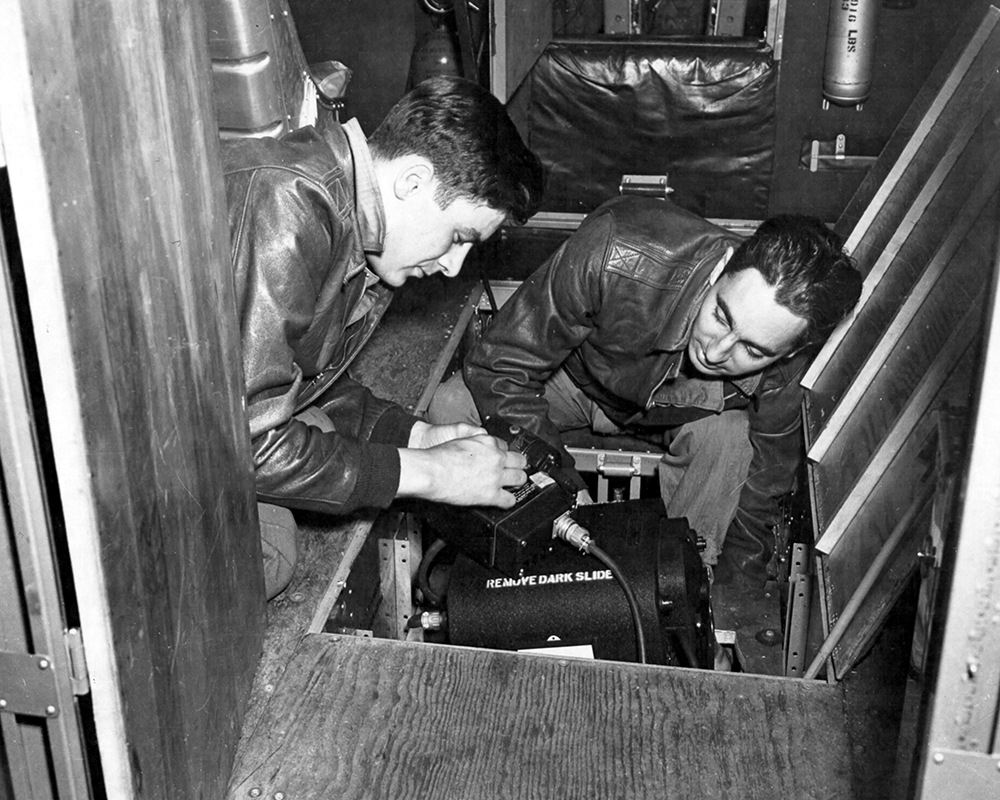
SSGTs Bill M. Lyon and John A. Feairheller install a strike camera aboard Our Gang (42-5069, 91BG).
Our Gang was lost over Schweinfurt on 17 August 1943.
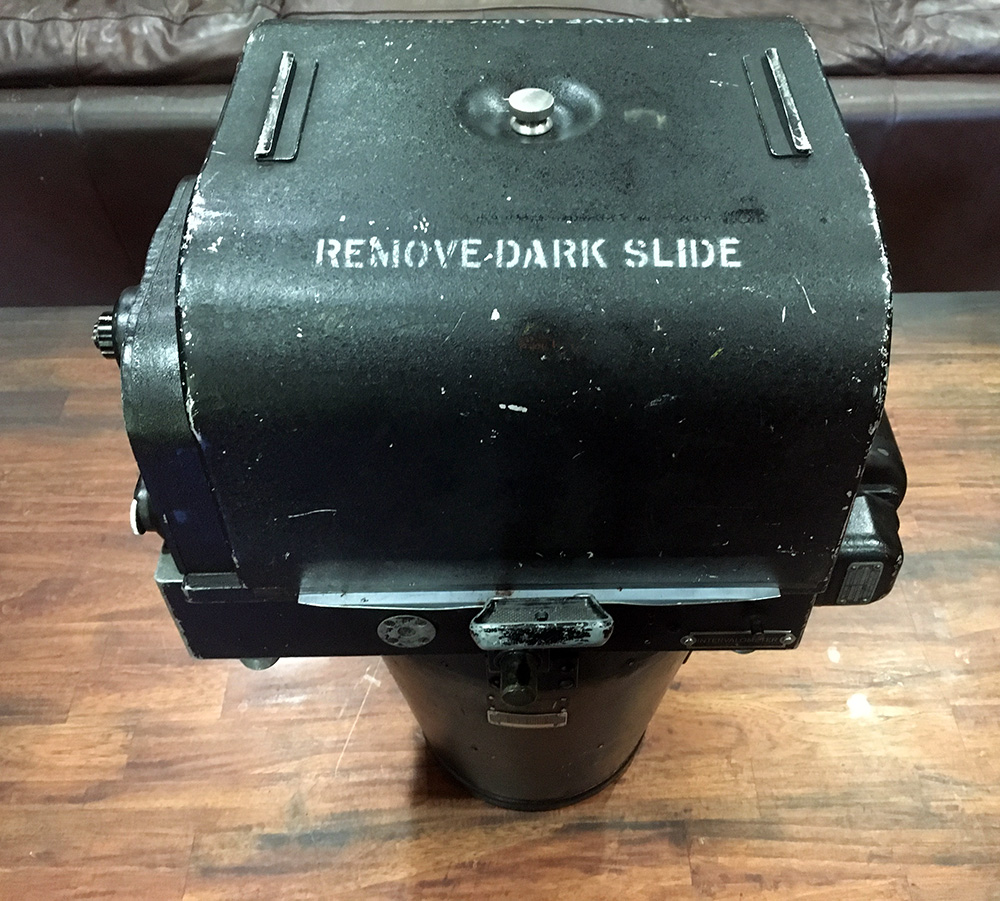
Top view of Max’s newly donated strike camera.
This upper assembly is a A-5A film magazine, which can take 190 exposures at 9 x 9 inches.
Photo taken 18 October 2021.
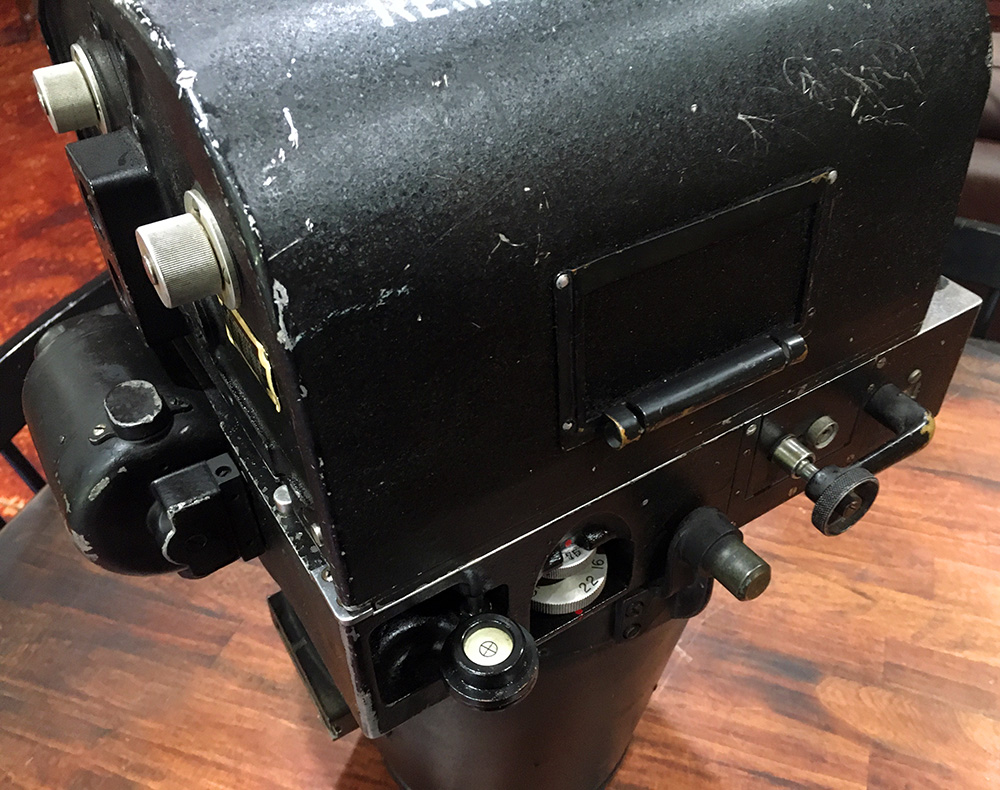
A Type K-17 strike camera was carried by Lucky Thirteen on two separate occasions – including the mission on which she was shot down.
Photo taken 18 October 2021.

The strike camera on the B-17 was kept in a bay beneath the floor of the radio compartment.
A pair of tiny trap doors allowed for the camera lens and viewfinder to poke through.
Photo taken 18 October 2021.
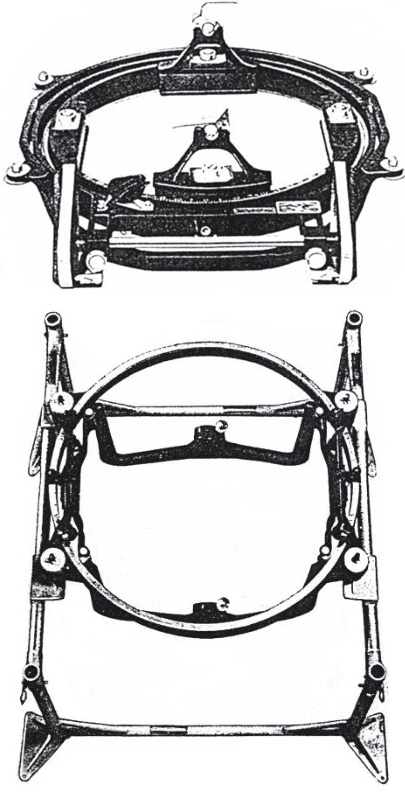
The Type K-17 camera was designed to be held by either the Type A-11 mount (above) or Type A-8 mount (below).

A manual illustration of a Type A-2 Vertical View Finder.
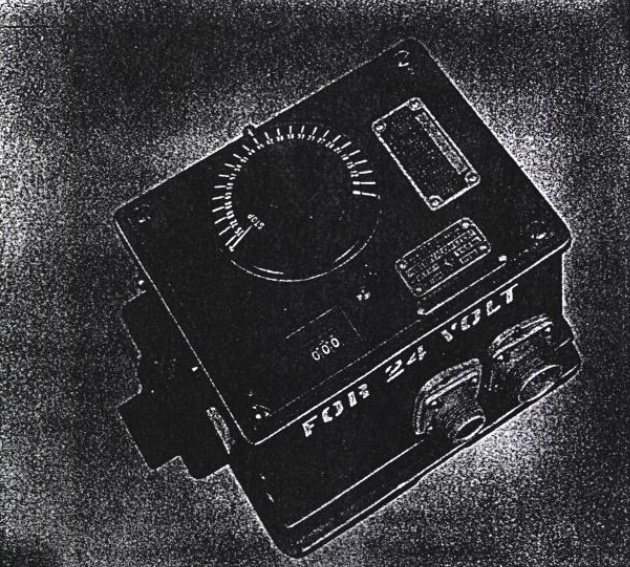
A rather rough illustration of the Type B-2 Camera Intervalometer.

A strike photo taken on 31 August 1943 over the Amiens-Glisy airfield.
This was the fifth combat mission flown by Lucky Thirteen.
Autumn is upon us and with it comes reunion season. Karl and Judy Hauffe will soon be off for the 100th Bomb Group’s reunion in Texas, and Chris and Mariola Wilkinson are already in Utah for the 384th Bomb Group’s reunion. Hope you guys have a great time!
Speaking of Chris, a few days ago, another crate from him arrived at the hangar. Long time followers may recall how Chris managed to track down the motor assemblies for the top and ball turrets. Well, now they are here! Sperry Gyroscope intentionally designed the motor assemblies for these turrets to be interchangeable, allowing both turrets to use the same system. An electric motor, based on the British Vickers design, sits between a pair of hydraulic transmissions – one controls elevation, the other azimuth. Connecting these transmissions to gear boxes inside the turret moves the entire assembly.
Chris went so far as to track down extras of each piece so that we have enough to restore both drive assemblies and still have spares to do regular maintenance. This is a huge step forward! Thanks Chris!
In other news, Ray has been hard at work (as usual). He has finished laying out and drilling the holes for Station 5’s skin. This is the forward wall of the radio compartment. The next steps will be to finish the brackets that fill out the bomb bay side of this bulkhead, begin laying out the spacers which attach to the skins (unique to insulated B-17 radio rooms, like on F models), and apply the ALCLAD markings.
Keith Krekel and Ted Smith of the Liberty Foundation have been up here this week too, riveting skins to the aft fuselage of Liberty Belle. Many hands make work light and they have made some amazing progress. And as an extra treat, they brought with them the Station 6 bulkhead from B-17G 44-83790. This is the back wall of the radio compartment and the factory middle point of the B-17’s fuselage. This will serve as a pattern for Station 6 in Lucky Thirteen.

The contents of Chris Wilkinson’s recent crate are laid out in front of Station 5 to Lucky Thirteen.
The three cylinders on the left are Vickers electric drive motors. The five square pieces are hydraulic transmissions.
The bright green piece is an A-4 Portable Oxygen Bottle. We need thirteen of these total, so if you have one you can spare…
Photo taken 7 October 2021.
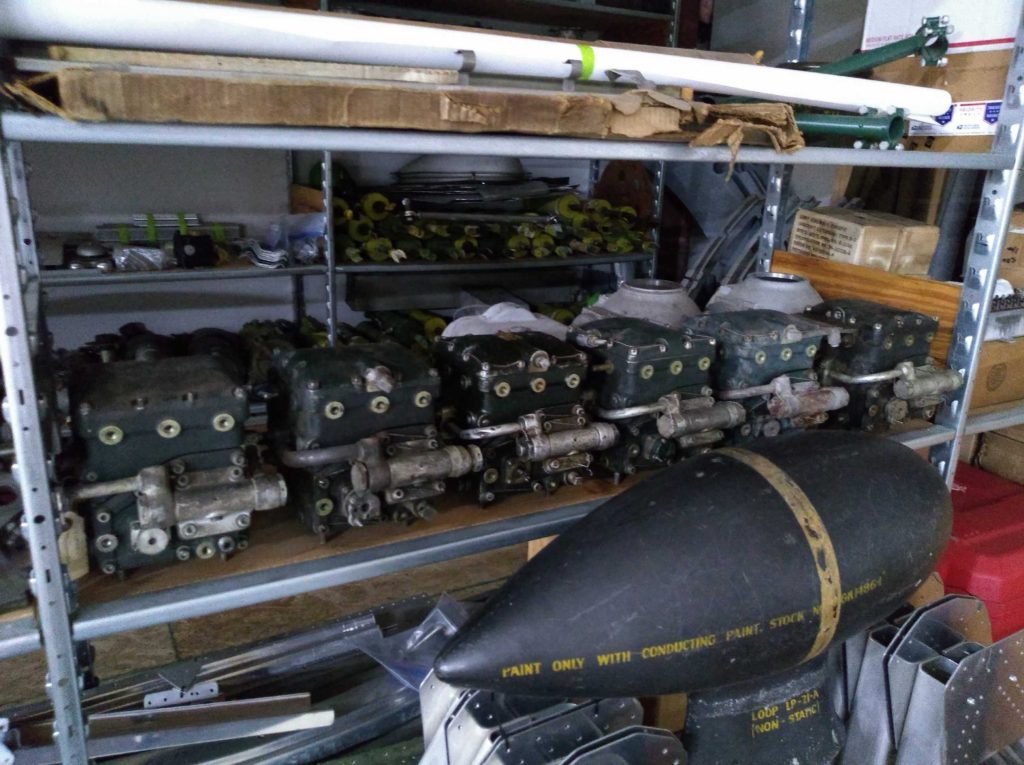
Hydraulic turret transmissions on our storage shelves. A sixth one was donated to us by Joe McKowen of Gaffney, South Carolina.
The large black football is a LP-21 football antenna, which is part of the B-17’s RDF system (radio direction finder). The silver bits underneath are the bracings which will go on the outer walls of the bomb bay, later connecting to the wings.
Photo taken 7 October 2021.
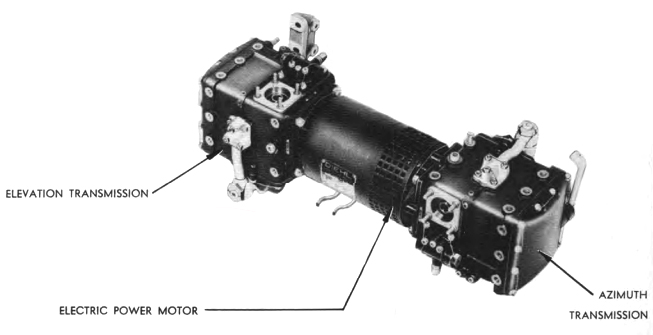
A manual illustration of the Sperry turret drive system.
The transmission for elevation and azimuth are identical, differing only in how they are mounted.
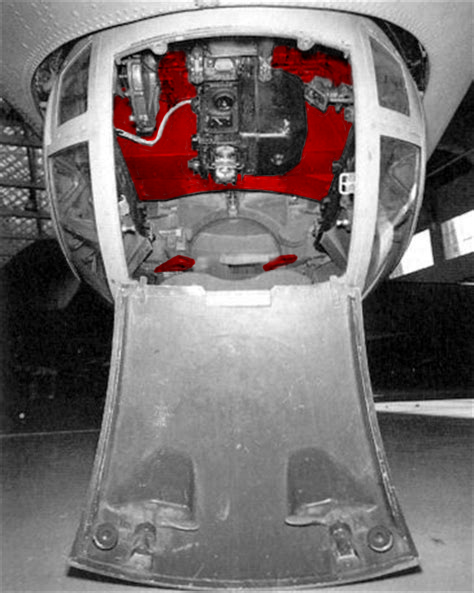
Our current progress on the Type A-2 ball turret for Lucky Thirteen is highlighted in red.
Strangely enough, it is easier to find parts for the ball turret than it is to find the actual body. The ball itself will have to be cast anew.
The drive assembly is located at the top, with the elevation and azimuth connector gears on either side.
In front of this assembly, taking up most of the room, is the ball turret’s ammunition magazine. It is a common myth that the ball turret’s ammunition was fed through external cans. External fed ball turrets were a late-war development, primarily seeing service aboard the short-lived Consolidated B-32.
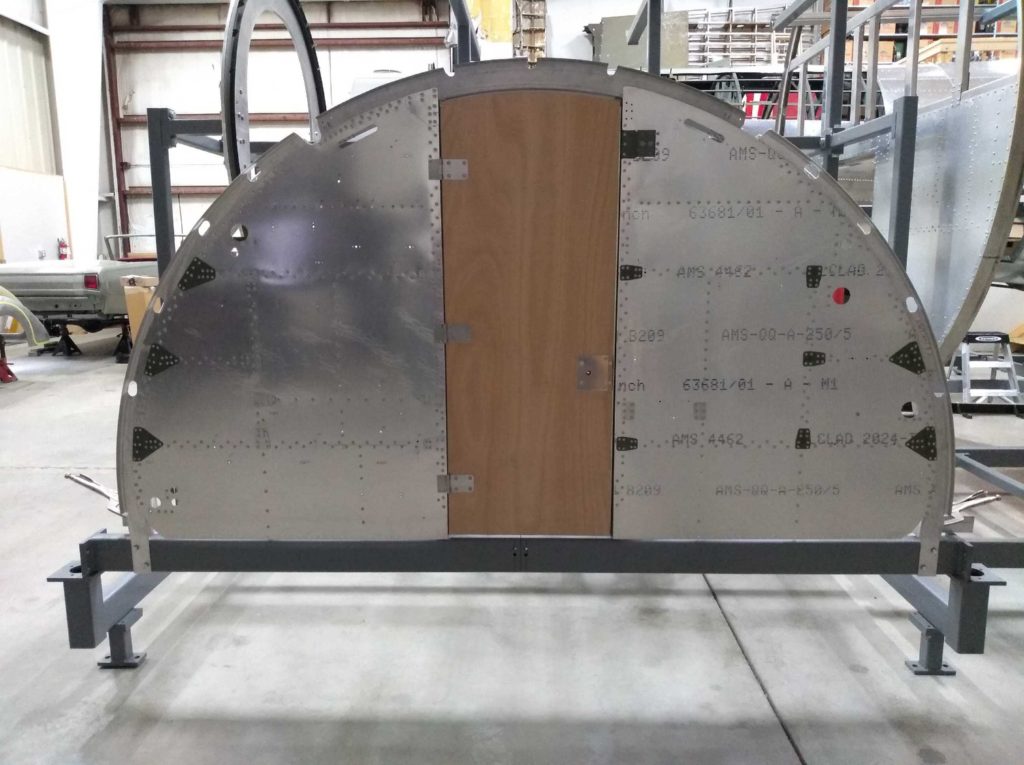
The radio side of Station 5.
The hinges were made by Midlake Products & Manufacturing using original blueprints.
It’s always thrilling to see my woodwork go into the airplane! Those doors were a TON of work – they’re hollow core, and also follow the blueprints to the letter.
Photo taken 7 October 2021.
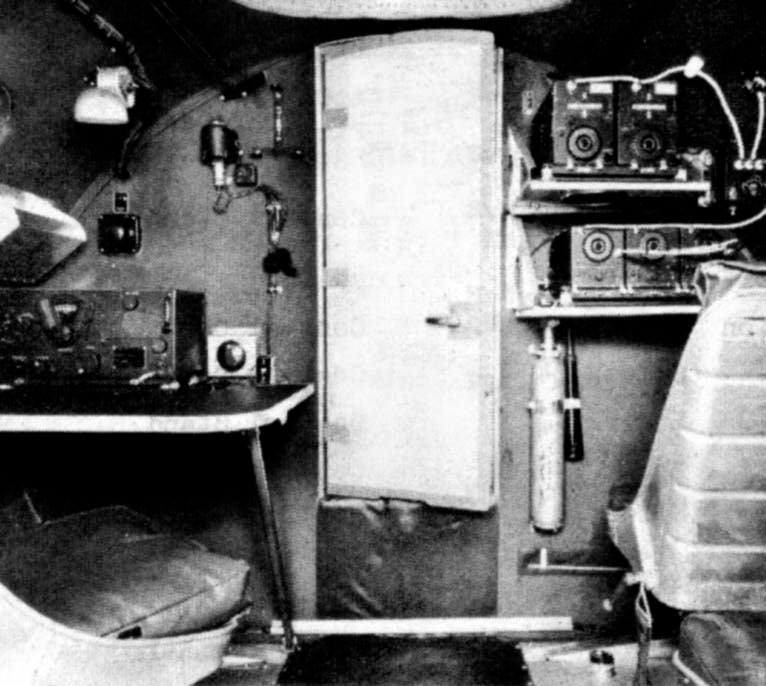
A manual photo showing Station 5 aboard a B-17F.
Not only was this compartment insulated in the F-series, but the dark section under the door was a leather scuff pad.
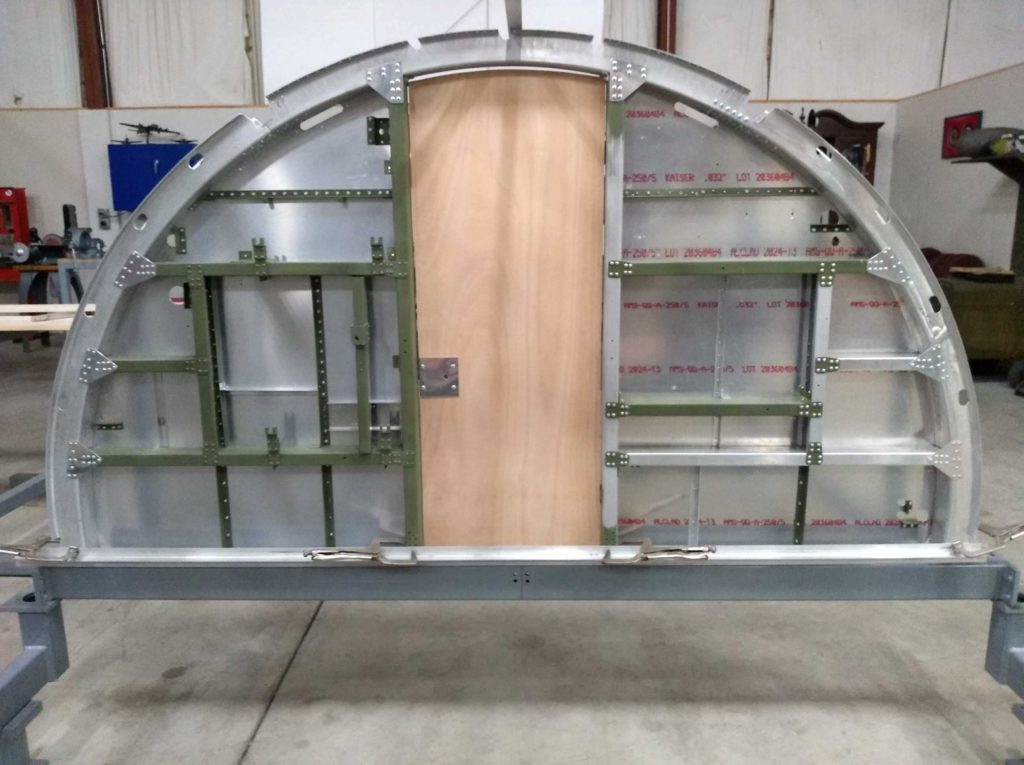
The bomb bay side of Station 5 from Lucky Thirteen.
The right side of this bulkhead held the bomb bay oxygen panel and the urine relief tube.
The left side of this bulkhead is where the bomb hoist assembly was stowed. While we have yet to locate an original bomb hoist rack, we have been able to track down the hoists themselves.
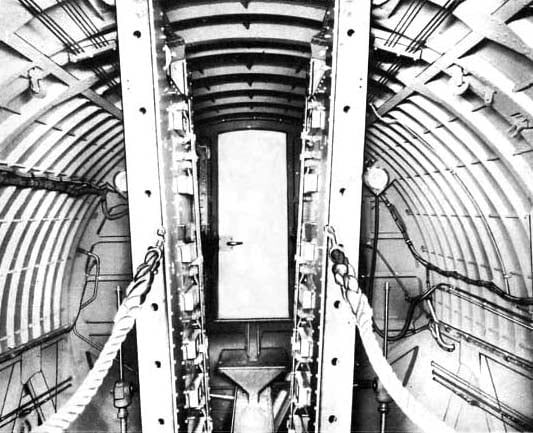
A manual illustration of Station 5, looking back from the cockpit into the bomb bay.
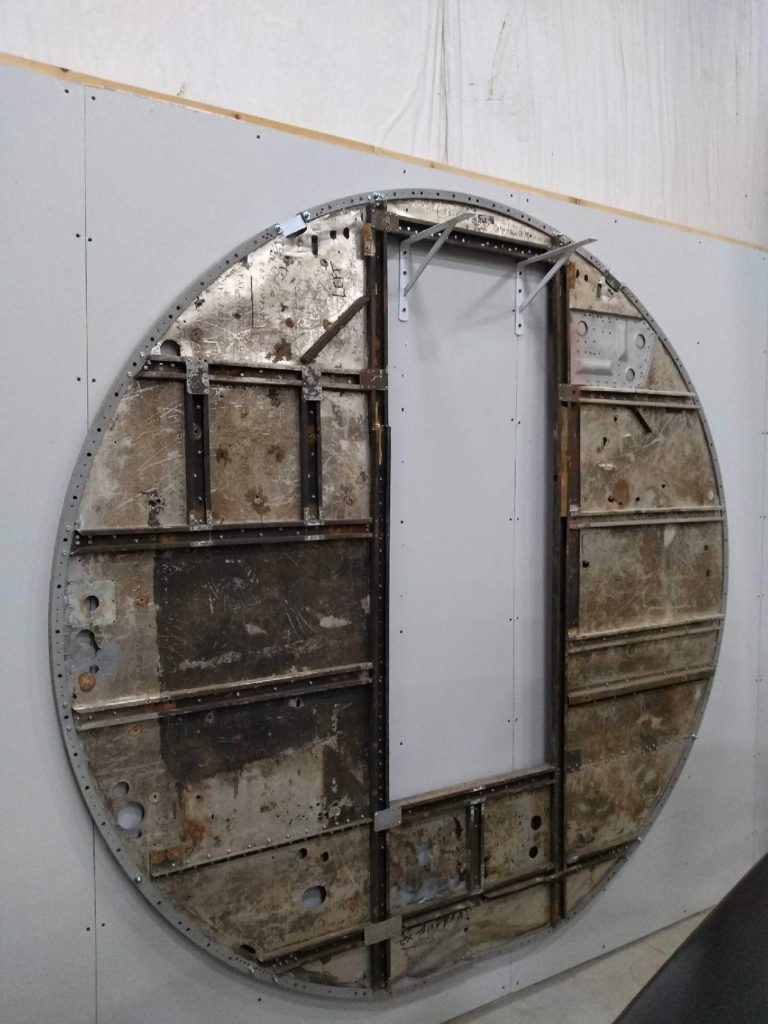
The newly arrived Station 6 from B-17G 44-83790.
Photo taken 7 October 2021.
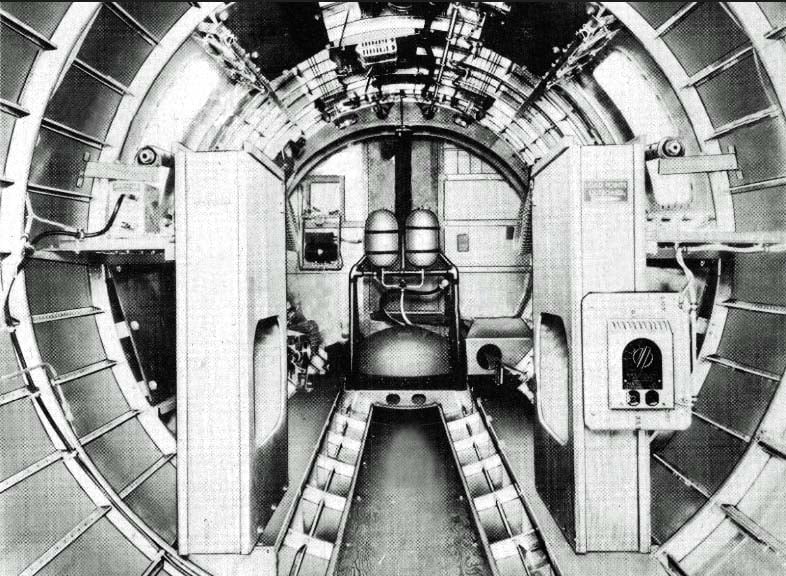
A manual illustration of Station 6, looking forward from the chemical toilet at the rear of the waist compartment.
The B-17F carried either a Sierra Manufacturing No. CC-4202 or Imperial Brass No. M-1019 chemical toilet. If anyone has one of these that they would be willing to contribute – or maybe just photograph and measure – please let us know!
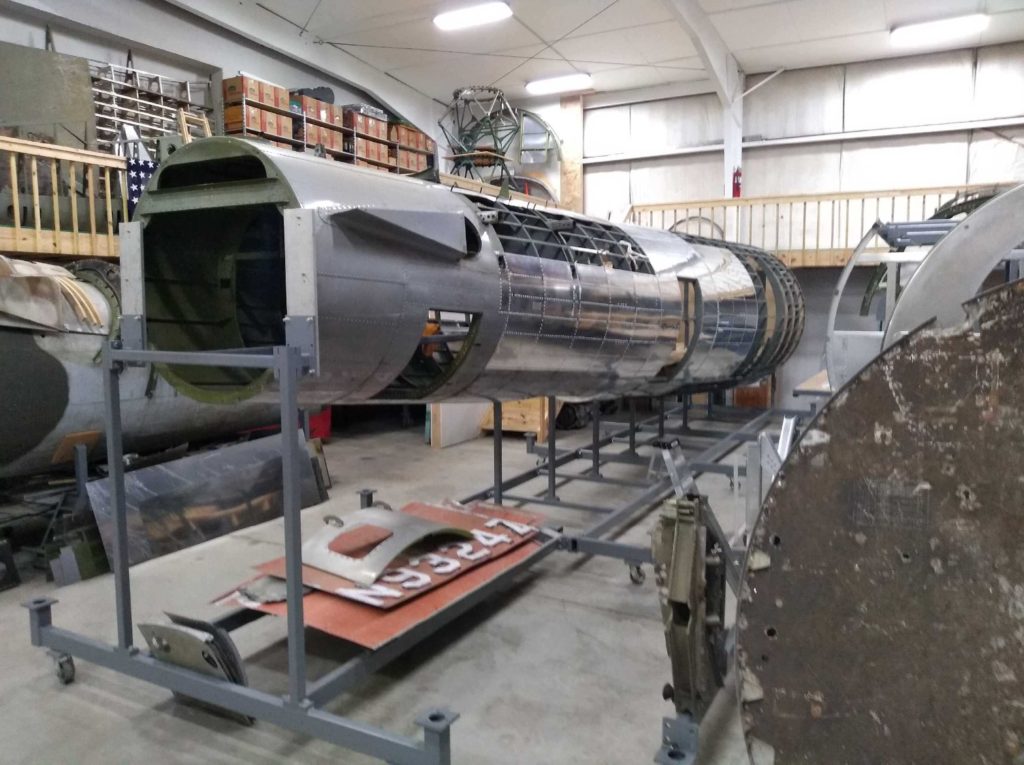
Progress photo of the aft fuselage from Liberty Belle.
Photo taken 7 October 2021.
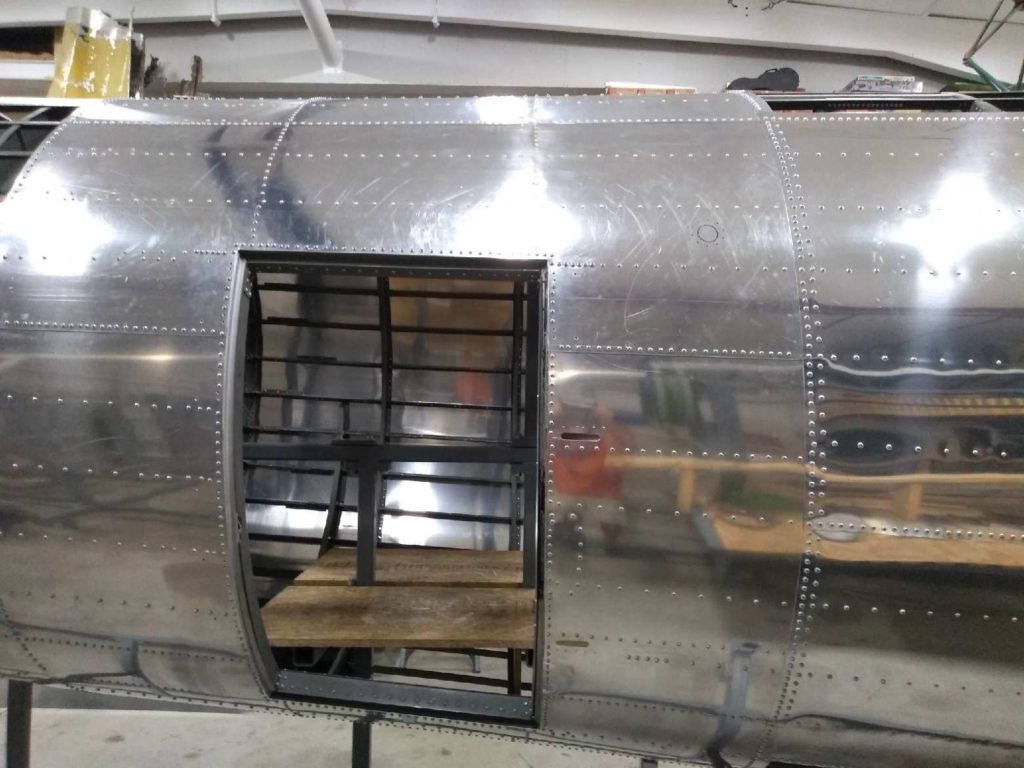
The waist entry door, newly reskinned, on the aft fuselage of Liberty Belle.
Photo taken 7 October 2021.
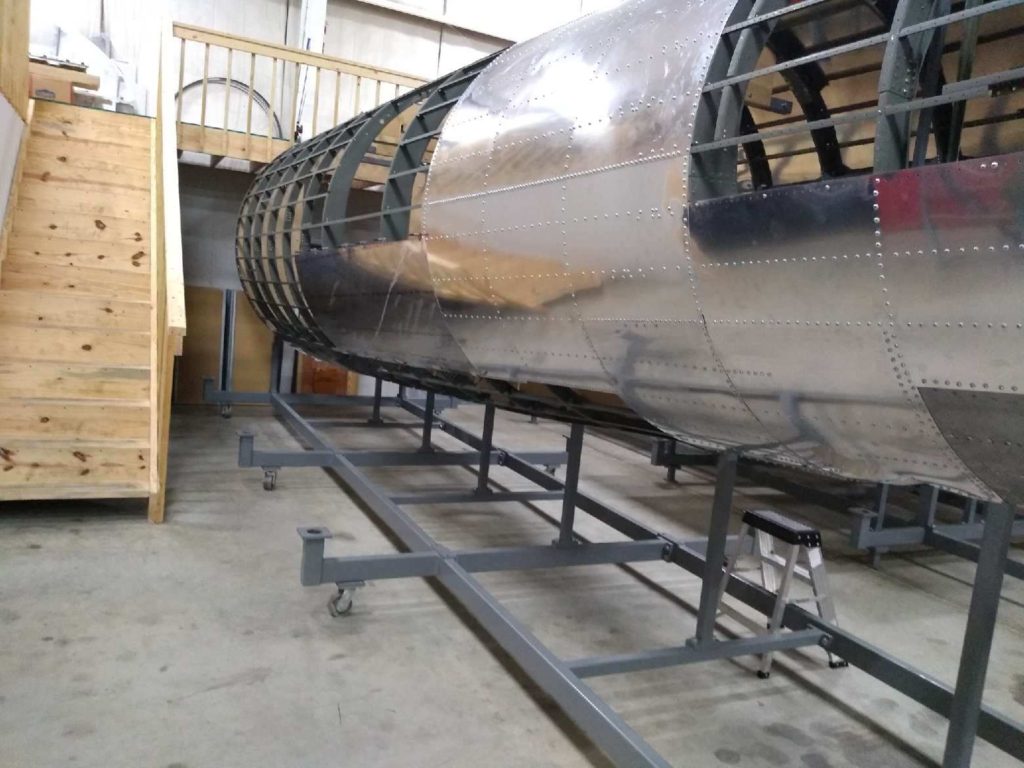
The port side of the aft fuselage from Liberty Belle.
Photo taken 7 October 2021.
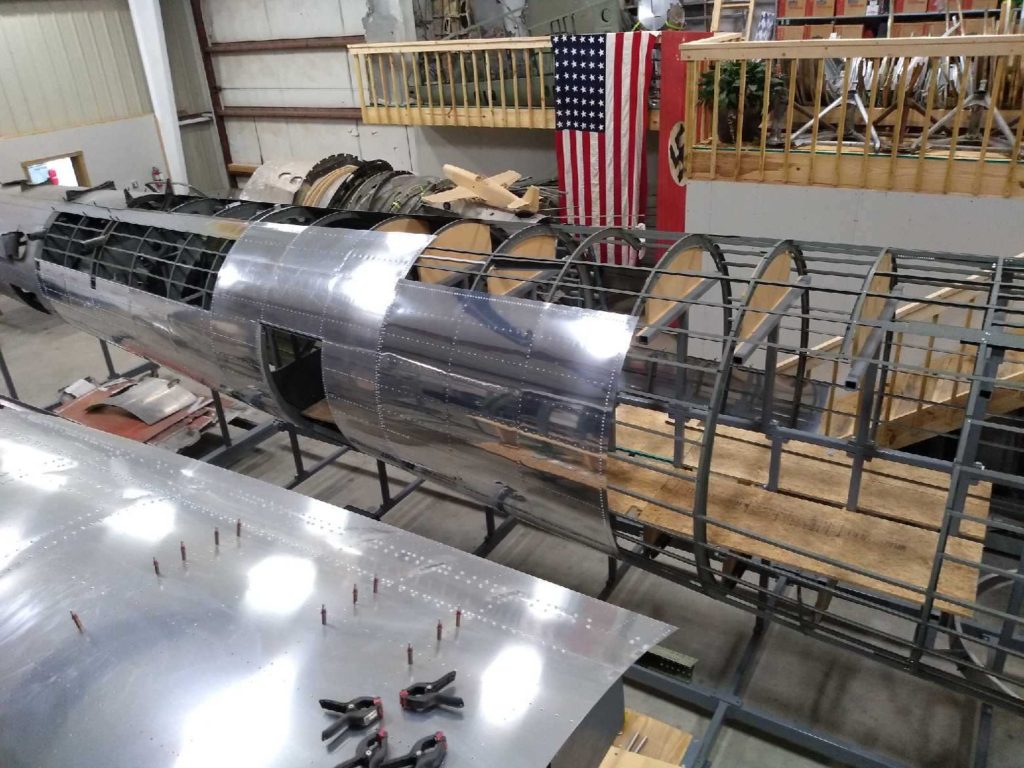
Looking down on the jigs holding the aft fuselage of Liberty Belle (right) and fore fuselage of Lucky Thirteen (left).
The skin on the left is the bomb bay roof of Lucky Thirteen.
Photo taken 7 October 2021.
